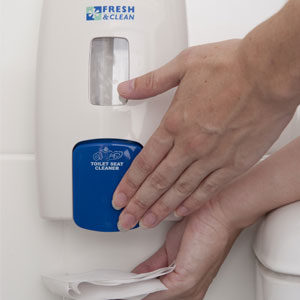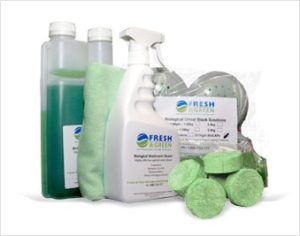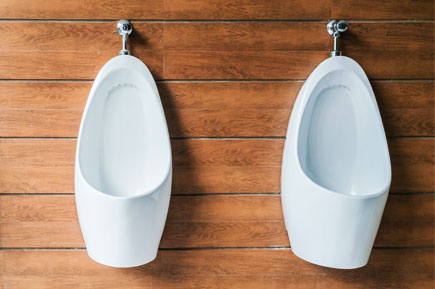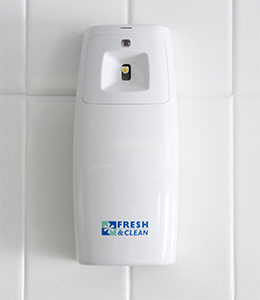Before today’s workplace urinals, Andrew Rankin was the pioneer of older designs in 1866.
Now, they are common all over the world and are a washroom necessity for relieving ourselves.
Unfortunately, managers often overlook workplace urinals. This shouldn’t be the case, as they play a major role in washroom hygiene.
This ultimate guide to urinals will lead your washroom experience to the next level.
Types of Urinals
To know which urinals suit your washrooms, you need to know the types that exist.
Urinals are under 3 major categories:
1. According to Flushing Mechanisms
Flushing is vital because it eliminates microorganisms found within the urinal.
To select a suitable urinal, you need to understand the different flushing mechanisms.
Manual Flushing
 Handy, accessible wall-mounted units Toilet Seat Sanitiser
Handy, accessible wall-mounted units Toilet Seat Sanitiser
This is a popular method. Workers press a button or pull on a lever to flush. This pushes the water from the cistern and into the urinal to flush waste. Flush handles are a common touchpoint. So, there is a high probability of spreading illnesses.
Make sanitiser available in washrooms so that workers can clean their hands after. But, there is an easier way out. Take the safe route for your workplace and avoid this flushing mechanism. Instead, select from the modern options below.
Automatic Flushing
This method prevents the need for physical contact. An infrared sensor detects movement and activates the flush.
If your workplace washrooms have the standard flushing handle, don’t fret. You can upgrade the urinals to this functionality.
Your workers benefit and feel more comfortable using washrooms. In turn, this boosts their morale and productivity.
Timed Flushing
Flushing occurs automatically within set intervals. This method ensures urinals remain clean and fresh-smelling.
Once the cistern water has reached its tipping point, all urinals flush together.
Link the flushing system to the washroom light switches to avoid wasting water.
Door-Regulated Flushing
Maintaining washroom hygiene is easier as urinals flush after the main door opens.
This mechanism saves water as flushing doesn’t occur when the doors stay shut at night.
2. According to Water Use
Some urinals use water, while others don’t.
Waterless Urinals Versus Flushing Urinals
Waterless urinals have been in existence since the 19th Century. They aim to eliminate the use of water while flushing.
The waste passes through a cartridge and into the drain without the need to flush. There’s no need to worry about pungent smells, as the cartridge absorbs them. Waterless urinals are the in-thing, and this is why:
- They are eco-friendly. They save between 57,000 and 170,000 litres of water per urinal, per year.
- Installation in high-populated areas is possible.
- Prevent the release of bad odours. Plus, provide the best brand of air fresheners to maintain a fresh-smelling workplace washroom.
- Proper installation leads to fewer problems.
Like any other device, waterless urinals have cons:
- They need constant maintenance because odour control is costly. Curb this by inquiring which odour controlling mechanism is long-lasting.
- The urinals should be compatible with your workplace building plumbing system. So, contact professionals to guide the way forward.3. According to Urinal Design
Urinal design is one of the best ways to understand your workplace washroom needs.
Not only does this give you the chance to spruce up the decor, but also, provides a sanitary option.
There are 3 main types of urinals designs:
Trough Urinal (TU)
This is an affordable urinal design that is shaped like an animal feeding trough. But, because of this, the little space available creates some awkwardness.
The plumbing leads to one drain and feeds from one cistern. Hence, this design is a common sight in public areas.
Bucket Urinal (BU)
As the name suggests, this urinal resembles a bucket.
It is a go-to choice for its plumbing variations. It is easier to adapt to your workplace washroom design to accommodate for it.
‘’Wee-Against-The-Wall’’ (WAW)
The name may not reflect the true aesthetic beauty they have. When put up by professionals, it can make a great conversation starter.
Unfortunately, this isn’t the best design to look to when saving costs. Installation on a tight budget makes it looks undesirable for your workers to use.
Buy the Right Urinals
After identifying the best design for your workplace washroom, you need to know where to buy it from.
With advances in technology, purchasing items is a piece of cake.
So, commercial online and physical bathroom stores are the way to go. A few local stores to choose from include:
- Macdonald Industries Limited.
- Paterson.
- Robertson Bathware.
- Archipro.
First, understand that stores sell urinals to meet different customers’ needs.
Thus, consider the following factors before purchasing your workplace urinals
Water Use
If you want your workplace to ”go green”, then you need urinals that conserve water. So, waterless urinals are an excellent choice
Flushing Mechanism
Select a urinal with sensors to track flushing frequency in the workplace washroom
Urinal Design
Washroom layout and design contribute to the productivity of workers. Select a design that promotes privacy and hygiene of your workers.
It should have enough space between washroom users to avoid a cramped up appearance.
Gender
To promote gender equality, there are both male and female urinals in the market. Conduct workplace surveys to understand the needs of your workers in this respect.
With these factors in mind, you can select the urinals that suit your workplace best. From this, there is a question about cost.
Instead of doing guesswork, have a look at this toilet calculator. It assists business owners in planning construction of washrooms.
Yet, the typical price range for urinals is between 199 to 900 Nz Dollars.
How to Install Urinals
Like any other appliance, you can install urinals yourself.
Consider these DIY installation tips before beginning your project:
- Ensure there is a steady water flow.
- Avoid tampering with electrical wires.
- Weld with care to prevent accidents.
Unfortunately, this option is not the best way to go for a professional job. Instead, trust the experts to do the job for you.
The benefits of hiring experts are:
- 5-star plumbing services are a phone call away.
- Knowledge and experience in local plumbing that your washrooms will.
- Facilitates the creation of a long-lasting relationship with the business.
Maintain Clean Urinals
 Clean your washrooms with Biological Treatment
Clean your washrooms with Biological Treatment
After all, urinals are a major part of the washroom. Without proper care, the state of your workplace washroom deteriorates.
For starters, splashbacks are a common incident in the urinal area.
In turn, bad odour and poor cleaning methods attract flies. This creates an unhygienic environment that may damage the reputation of your business.
Investing in urinal tabs is one of the surefire ways to deal with these problems. They consist of a chemical that controls odour and bacteria formation.
Urinal tabs are heavy-duty products that also repel silverfish and moths. All you have to do is place the tab at the bottom of the urinal and replace them often.
Additionally, consider hiring cleaning professionals that offer the following services:
Deep Cleaning
This is a 4-step process that involves the elimination of dirt from hard-to-reach areas.
Deep cleaning is suitable for washing the outer area of urinals
Biological Treatment
This treatment is a permanent solution to smelly and clogged urinal drains.
According to the experts, this is an effective option that removes the build-up of uric acid.
Consider using a combination of these 2 services for extraordinary results. As a result, the maintenance of washroom hygiene is a piece of cake.
Plus, install wet area mats nearby urinals to absorb any splashback that may occur. Clean and replace them to upkeep the washroom appearance.
In the long run, high-quality and sanitary urinals are a great workplace asset, as:
- It upholds your business’ reputation and reflects its core values.
- It enhances your workers comfort at work.
- This contributes to people’s general satisfaction with the workplace




